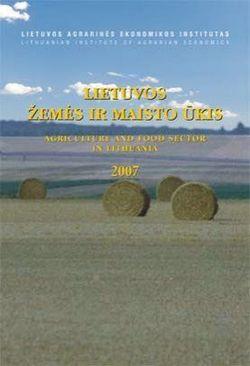
Analytical review of the Lithuanian agriculture and food sector in the previous year. This publication is aimed at providing information to the representatives of governmental and self-governing authorities, scientific research and study institutions, and all interested in the development of agriculture and food sector, pisciculture and rural areas.
The year 2007 was the first year of the new EU programming period. Following the provisions of the EU CAP and the national policy on agricultural and food sector, including rural development, the National Rural Development Strategy and Rural Development Programme for Lithuania for the period 2007-2013 have been prepared. The Rules for the implementation of the Programme were adopted and other legal acts related to the administration of measures under this programme were approved.
Lithuanian agricultural entities and food industry enterprises were able to take the advantages of free movement of goods and capital in the single market, and implement modernisation projects through the EU support, strengthening significantly their competitive abilities.
In 2007, as compared to 2006, the turnover of foreign trade in agricultural and food products increased almost by 30%, amounting to LTL 13,4 billion, and accounting for 17% of the total amount of the national foreign trade. Over 2007, export of Lithuanian agricultural and food products increased by 36% and totalled to LTL 7,4 billion; import increased by 28% and amounted to LTL 6,1 billion. The positive foreign trade balance amounted nearly to LTL 1,3 billion. Dairy products made up the largest share in the structure of the total export of agricultural products. Germany, Latvia, Poland and other EU countries, as well as Russia, were the major partners of Lithuania‘s foreign trade.
In 2007, as compared to the unfavourable year of 2006, gross agricultural output increased by 33% and exceeded LTL 6,5 billion. The value of gross crop output went up by 49%, and of animal output by 19%. Animal husbandry was for a long time a leading branch in the sector, but gave the leading position to the crop production branch, which created 52% of the total value of gross agricultural production in 2007.
Positive tendencies in agriculture were conditioned by a rapid increase of farmers’ income: in 2007 the average monthly disposable income per household member amounted to LTL 969,6. It slightly exceeded the income of urban population and noticeably overtook the average income of the total rural population. The gap between the average earnings in the country and in agriculture has decreased: wages in agriculture were growing up more rapidly than the national average and increased by 28%.
In 2007, 101 thousand of family farms and 586 of agricultural companies and enterprises were registered and operational. With reference to the data of crop declarations of all agricultural entities in 2007, the average farm size was 13,4 ha, i.e. by 8.1% larger than in 2006.
A considerable share of small semi-subsistent farms, senior age and insufficient education of farmers are the main obstacles impeding labour productivity and competitiveness in agricultural production. Therefore, training of human resources is a priority in the development of agriculture and food sector.
The main fishing regions of the Lithuanian marine fishing fleet are the Atlantic ocean and the Baltic sea, since 2007 the Pacific ocean as well. Over 2007, fish catches increased nearly by 25% and amounted to 190,6 thou. tons. Fish catches in inland waters totalled to 5,3 thou. tons, of which 64% accounted for pond fish production.
The EU social policy and financial support encouraged social activeness of the rural population. In 2007 there were 1,3 thousand of registered rural communities in Lithuania and 45 local action groups (LAG) covering almost the entire rural territory of the country. 10 LAGs have prepared local development strategies, the implementation of which is financed from the Rural orientation and guarantee fund.
© Quoting requires reference to the source and website address.
